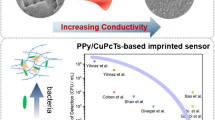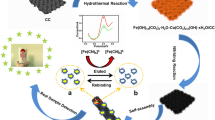Abstract
As a macrolide antibiotic, erythromycin is often used to treat bacterial infections in animal husbandry, but excessive use of erythromycin will make its residue in the animal and subsequently enter the human body through consumption, furthermore causing a different degree of damage to human health. It is quite essential to develop a fast and precise quantitative detection manner for erythromycin. In this study, we use arginine as a functional monomer and erythromycin as a template molecule to electro-polymerize a layer of molecularly imprinted polymer film on the surface of a glassy carbon electrode, and then use it as a recognition element to achieve quantitative erythromycin monitoring. The linear detection range of the prepared electrochemical sensor is from 3 nM to 1600 µM, the lowest detection limit (S/N = 3) is 2.01 nM, and the sensitivity is 57,300 µA cm−2 µM−1. The selectivity, reproducibility, and stability of the electrochemical sensor are satisfactory. At the same time, it can monitor whether honey contains erythromycin and its concentration, the recovery rate from 96.4 to 104.2%. After a series of performance tests, the results indicated that the Arg-MIP/GCE sensor has the potential to be applied in the measurement of erythromycin, which exists in food and agro-products.











Similar content being viewed by others
Data availability
This work described has not been published before. All data generated or analyzed during this study are included in this published article.
References
Y. Du et al., Preparation of DNA aptamer and development of lateral flow aptasensor combining recombinase polymerase amplification for detection of erythromycin. Biosens. Bioelectron. 181, 113157 (2021)
A.M. Shrivastav et al., Highly sensitive and selective erythromycin nanosensor employing fiber optic SPR/ERY imprinted nanostructure: application in milk and honey. Biosens. Bioelectron. 90, 516 (2017)
N. Li et al., A novel molecularly imprinted electrode modified with carbon nanohorn and polydopamine for highly sensitive determination of erythrocin in food. Microchem. J. 181, 107728 (2022)
N. Tarannum et al., Perspective and application of molecular imprinting approach for antibiotic detection in food and environmental samples: a critical review. Food Control 118, 107381 (2020)
S.R. Shrivastava et al., Responding to the challenge of antibiotic resistance: World health organization. J. Res. Med. Sci. 23, 21 (2018)
L.H. Kahn, Antimicrobial resistance: a one health perspective. Trans. R. Soc. Trop. Med. Hyg. 111, 255 (2017)
Y. Chen et al., Comprehensive insights into the occurrence, distribution, risk assessment and indicator screening of antibiotics in a large drinking reservoir system. Sci. Total Environ. 716, 137060 (2020)
S. Asgari et al., Super-porous semi-interpenetrating polymeric composite prepared in straw for micro solid phase extraction of antibiotics from honey, urine and wastewater. J. Chromatogr. A 1631, 461576 (2020)
F. Kamarei et al., Development of a stability-indicating high performance liquid chromatography method for assay of erythromycin ethylsuccinate in powder for oral suspension dosage form. Arab. J. Chem. 7, 1079 (2014)
S. Jeelani, N. Soukhova, Development and validation of a stability indicating HPLC method for organic impurities of erythromycin stearate tablets. J. Pharm. Biomed. Anal. 195, 113858 (2021)
R. Pascale et al., Validation of a liquid chromatography coupled with tandem mass spectrometry method for the determination of drugs in wastewater using a three-phase solvent system. J. Sep. Sci. 43, 886 (2020)
J. Xu et al., Fingerprinting bacterial metabolic response to erythromycin by raman-integrated mid-infrared photothermal microscopy. Anal. Chem. 92, 14459 (2020)
X.A. Ton et al., Direct fluorimetric sensing of UV-excited analytes in biological and environmental samples using molecularly imprinted polymer nanoparticles and fluorescence polarization. Biosens. Bioelectron. 36, 22 (2012)
Y. Zhang et al., Selective fluorescence labeling and sensitive determination of staphylococcus aureus by microchip electrophoresis with a multiple-concentration approach. Chin. Chem. Lett. 29, 1383 (2018)
L.M. Chiesa et al., Analysis of antibiotic residues in raw bovine milk and their impact toward food safety and on milk starter cultures in cheese-making process. Lwt 131, 109783 (2020)
B. Du et al., Evaluation of an ELISA-based visualization microarray chip technique for the detection of veterinary antibiotics in milk. Food Control 106, 106713 (2019)
Q. Wu et al., A microbiological inhibition method for the rapid, broad-spectrum, and high-throughput screening of 34 antibiotic residues in milk. J. Dairy. Sci. 102, 10825 (2019)
W. Yu et al., Preparation of a carboxylated single-walled carbon-nanotube-chitosan functional layer and its application to a molecularly imprinted electrochemical sensor to quantify semicarbazide. Food Chem. 333, 127524 (2020)
M.R. Ali et al., A highly sensitive poly-arginine based MIP as an electrochemical sensor for selective detection of dimetridazole. Anal. Chim. Acta 1121, 11 (2020)
H. Jin et al., Selective and sensitive electrochemical sensing of gastrodin based on nickel foam modified with reduced graphene oxide/silver nanoparticles complex-encapsulated molecularly imprinted polymers. Sens. Actuat. B-Chem. 277, 14 (2018)
T.S. Anirudhan et al., Electrochemical sensing and nano molar level detection of bisphenol-A with molecularly imprinted polymer tailored on multiwalled carbon nanotubes. Polymer 146, 312 (2018)
Z. Lu et al., Novel dual-template molecular imprinted electrochemical sensor for simultaneous detection of CA and TPH based on peanut twin-like NiFe2O4/CoFe2O4/NCDs nanospheres: fabrication, application and DFT theoretical study. Biosens. Bioelectron. 190, 113408 (2021)
A. Cetinkaya et al., A molecularly imprinted electrochemical sensor based on highly selective and an ultra-trace assay of anti-cancer drug axitinib in its dosage form and biological samples. Talanta 233, 122569 (2021)
B. Song et al., Selective and sensitive determination of erythromycin in honey and dairy products by molecularly imprinted polymers based electrochemical sensor. Microchem. J. 116, 183 (2014)
W. Lian et al., Electrochemical sensor based on gold nanoparticles fabricated molecularly imprinted polymer film at chitosan-platinum nanoparticles/graphene-gold nanoparticles double nanocomposites modified electrode for detection of erythromycin. Biosens. Bioelectron. 38, 163 (2012)
A.G. Ayankojo et al., Molecularly imprinted polymer-based sensor for electrochemical detection of erythromycin. Talanta 209, 120502 (2020)
M.A. Beluomini et al., Electrochemical sensors based on molecularly imprinted polymer on nanostructured carbon materials: a review. J. Electroanal. Chem. 840, 343 (2019)
G. Ozcelikay et al., Au-Pt nanoparticles based molecularly imprinted nanosensor for electrochemical detection of the lipopeptide antibiotic drug daptomycin. Sens. Actuat. B-Chem. 320, 128285 (2020)
S. Motia et al., An electrochemical molecularly imprinted sensor based on chitosan capped with gold nanoparticles and its application for highly sensitive butylated hydroxyanisole analysis in foodstuff products. Talanta 223, 121689 (2021)
S. He et al., Poly(glycine)/graphene oxide modified glassy carbon electrode: Preparation, characterization and simultaneous electrochemical determination of dopamine, uric acid, guanine and adenine. Anal. Chim. Acta 1031, 75 (2018)
M. Hasanzadeh et al., Poly arginine-graphene quantum dots as a biocompatible and non-toxic nanocomposite: layer-by-layer electrochemical preparation, characterization and non-invasive malondialdehyde sensory application in exhaled breath condensate. Mater. Sci. Eng. C Mater. Biol. Appl. 75, 247 (2017)
Y. Li et al., A new voltammetric sensor based on poly(l-arginine)/graphene–nafion composite film modified electrode for sensitive determination of terbutaline sulfate. J. Electroanal. Chem. 687, 51 (2012)
B. Thirumalraj et al., Highly sensitive electrochemical detection of palmatine using a biocompatible multiwalled carbon nanotube/poly-l-lysine composite. J. Colloid Interface Sci. 498, 144 (2017)
F. Zhang et al., Simultaneous electrochemical determination of uric acid, xanthine and hypoxanthine based on poly(l-arginine)/graphene composite film modified electrode. Talanta 93, 320 (2012)
Y. Yang et al., Electrochemical sensor based on molecularly imprinted polymer film via sol-gel technology and multi-walled carbon nanotubes-chitosan functional layer for sensitive determination of quinoxaline-2-carboxylic acid. Biosens. Bioelectron. 47, 475 (2013)
W. Li et al., A highly-sensitive and selective antibody-like sensor based on molecularly imprinted poly(l-arginine) on COOH-MWCNTs for electrochemical recognition and detection of deoxynivalenol. Food Chem. 350, 129229 (2021)
D.B. Kim et al., Investigation and human health risk assessment of multi-class veterinary antibiotics in honey from south korea. J. Food Compos. Anal. 102, 104040 (2021)
J. Xu et al., Multiresidue analysis of 15 antibiotics in honey using modified quechers and high-performance liquid chromatography-tandem mass spectrometry. J. Food Compos. Anal. 103, 104120 (2021)
W.B. Veloso et al., Rapid and sensitivity determination of macrolides antibiotics using disposable electrochemical sensor based on super P carbon black and chitosan composite. Microchem. J. 172, 106939 (2022)
J. Peng et al., Blue-light photoelectrochemical sensor based on nickel tetra-amined phthalocyanine-graphene oxide covalent compound for ultrasensitive detection of erythromycin. Biosens. Bioelectron. 106, 212 (2018)
M. Okan, M. Duman, Functional polymeric nanoparticle decorated microcantilever sensor for specific detection of erythromycin. Sens. Actuat. B-Chem. 256, 325 (2018)
A. Veseli et al., Electrochemical determination of erythromycin in drinking water resources by surface modified screen-printed carbon electrodes. Microchem. J. 148, 412 (2019)
Y. Xie et al., Simultaneous determination of erythromycin, tetracycline, and chloramphenicol residue in raw milk by molecularly imprinted polymer mixed with solid-phase extraction. Food Anal. Methods 11, 374 (2017)
Y. Zhang et al., Sio2-mip core-shell nanoparticles containing gold nanoclusters for sensitive fluorescence detection of the antibiotic erythromycin. Microchim. Acta. 184, 2241 (2017)
Acknowledgements
This work was supported by the National Natural Science Foundation of China (Grand No. 61761047 and 41876055), Yunnan University’s Research Innovation Fund for Graduate Students (2021Z096), the Yunnan Provincial Department of Science and Technology through the Key Project for the Science and Technology (Grant No. 2017FA025), and Program for Innovative Research Team (in Science and Technology) in University of Yunnan Province.
Author information
Authors and Affiliations
Contributions
All authors contributed to the work conception and design. TL: Investigation, Original draft preparation. HB and XX: Investigation, Writing—Original draft preparation. HS, XT, XC, and JR: Data curation and Methodology. YW: Supervision, Writing—Reviewing and Editing. All authors read and approved the final manuscript.
Corresponding authors
Ethics declarations
Conflict of interest
The authors have no relevant financial or non-financial interest to disclose.
Ethical approval
The work contains no libelous or unlawful statements, does not infringe on the rights of others, or contains material or instructions that might cause harm or injury.
Additional information
Publisher’s Note
Springer Nature remains neutral with regard to jurisdictional claims in published maps and institutional affiliations.
Rights and permissions
Springer Nature or its licensor (e.g. a society or other partner) holds exclusive rights to this article under a publishing agreement with the author(s) or other rightsholder(s); author self-archiving of the accepted manuscript version of this article is solely governed by the terms of such publishing agreement and applicable law.
About this article
Cite this article
Lai, T., Shu, H., Tian, X. et al. Electrochemical sensor based on molecularly imprinted poly-arginine for highly sensitive and selective erythromycin determination. J Mater Sci: Mater Electron 34, 6 (2023). https://doi.org/10.1007/s10854-022-09405-0
Received:
Accepted:
Published:
DOI: https://doi.org/10.1007/s10854-022-09405-0




